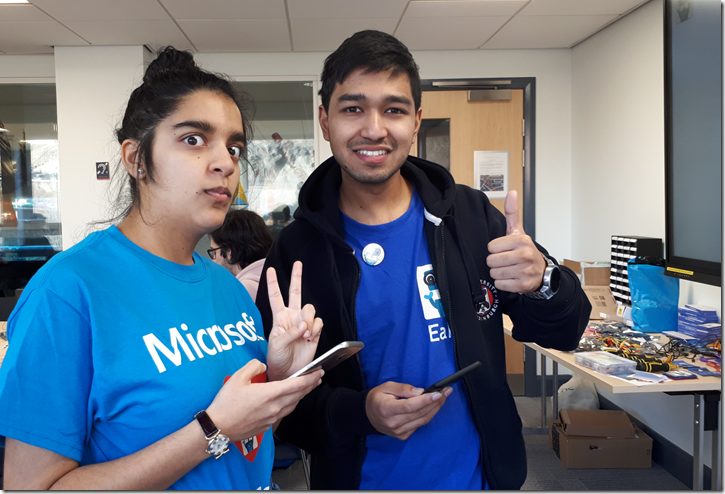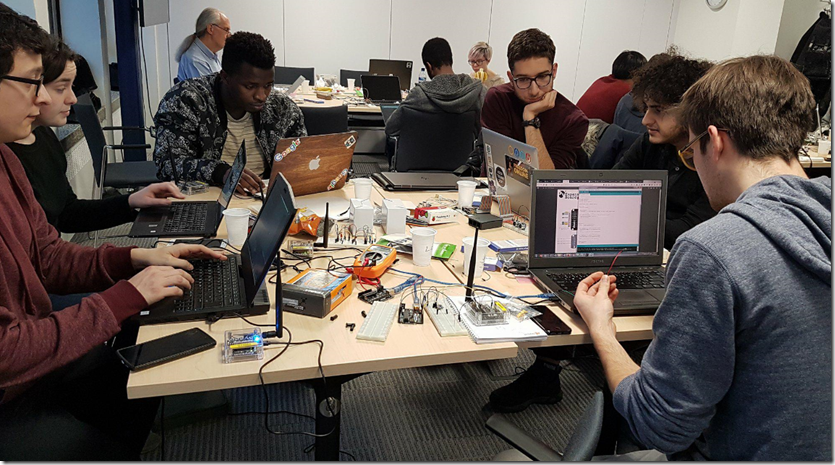Getting Started with IoT and Microsoft Azure
The Festival of Creative Learning is a week long break from teaching during second semester at the University of Edinburgh. It features all sorts of events that teach people about new disciplines in fun, innovative ways. Enter the IoT Challenge - a 3 day event of making and coding during which participants created new IoT applications in teams. All this was, of course, fuelled by pizza and apple juice.  The motivation behind running the event was that the University of Edinburgh is creating its own LoRaWAN network (a bit like a city-wide Wi-Fi for IoT devices) that they want people to use for interesting projects.
The motivation behind running the event was that the University of Edinburgh is creating its own LoRaWAN network (a bit like a city-wide Wi-Fi for IoT devices) that they want people to use for interesting projects.  The teams had access to Microsoft Azure https://aka.ms/azure4students Lots of hardware including RaspberryPi, Ardiuno and LoPy boards and a vast store of electronic components and sensors provided which could access the network and play with. The hacks are all uploaded to Devpost for the event at https://iot-challenge-2018.devpost.com/submissions
The teams had access to Microsoft Azure https://aka.ms/azure4students Lots of hardware including RaspberryPi, Ardiuno and LoPy boards and a vast store of electronic components and sensors provided which could access the network and play with. The hacks are all uploaded to Devpost for the event at https://iot-challenge-2018.devpost.com/submissions
The winning project
Was team Gamma with a project called “IoT Irrigation”. It consisted of low power Pycom LoPy boards that collected data about fields and then sent it through to an Azure back-end for processing. The server on Azure would decide when to turn on irrigation valves based on the incoming sensor data and external factors and then send that schedule back to the LoPy for it to execute. . Github which can be found here< https://github.com/billyjason/smart-irrigation >. The project's readme.md and presentation.pptx on GitHub provide more information about the infrastructure and solutions proposed to be used of our projects,  We used the Azure cloud service in the following way, our Lopy's micro controllers were communicating with cloud Azure cloud directly without any other intermediary device, and also we used Azure's Redis as a database for data being sent either from the sensors, which we later could use for further analysis. All team members : - Billy Byiringiro - Computer Science with Management -David Kamberský – Computer Science -Nina Caisova – Computer Science and AI -Uhlirjan – Electrical Engineering -Lorenzo Conti - Infrastrutture and Environment Engineering.
We used the Azure cloud service in the following way, our Lopy's micro controllers were communicating with cloud Azure cloud directly without any other intermediary device, and also we used Azure's Redis as a database for data being sent either from the sensors, which we later could use for further analysis. All team members : - Billy Byiringiro - Computer Science with Management -David Kamberský – Computer Science -Nina Caisova – Computer Science and AI -Uhlirjan – Electrical Engineering -Lorenzo Conti - Infrastrutture and Environment Engineering.
The team overcame some really interesting technical challenges and it was a thoroughly deserved win. Well done to David Kambersky, Nina Caisova, Billy Byiringiro, Jan Uhlir and Lorenzo Conti
Runner up project
Was equally impressive and came under the name “Smart IoT Lock”. The concept was to use blockchain transactions to open locks, thus opening the door to machine-to-machine transactions in, for example, toll gates on motorways. The team used IOTA as their blockchain since it has the ability to not only send value with transactions, but also send transactions that have zero-cost which is useful when you are unlocking your home. The boffins behind this were Alan Savio Paul, Nicola Sorace, Efe Sinan Hoplamaz, Anubhav Chakravarty and Gurz Singh. Along the way our participants faced some really interesting technical challenges. One example from the IoT Irrigation team was that they had to code their own HTTP library to communicate with Azure from the LoPy boards since it ran Micropython with no built in library for this other than socket support. Getting Azure for this event really helped both the organisers and the participants. The following Azure IoT workshops are also available for those wishing to learn more about IoT and Azure https://github.com/Microsoft/computerscience/tree/master/Labs/Internet-of-Things https://github.com/Microsoft/computerscience/tree/master/Labs/Content%20in%20draft/Azure%20IoT Comments from Cameron MacLeod, Partnership Manager, EaRS Edinburgh
The organising side, it was far easier to write a workshop with Azure than other cloud based platforms that we have used before. This was mostly due to the ease of setting up an application in Azure and the quantity of existing good-quality tutorials. The participants loved it because it allowed them to learn new skills in an easy to use environment and it removed many technical challenges with cloud applications that they would have had to deal with themselves otherwise, allowing them to focus on their applications.
The society behind the hack is the Embedded and Robotics Society and we have another hackathon coming up in April. https://createdhack.github.io. Congratulations to the Winners and attendees. 